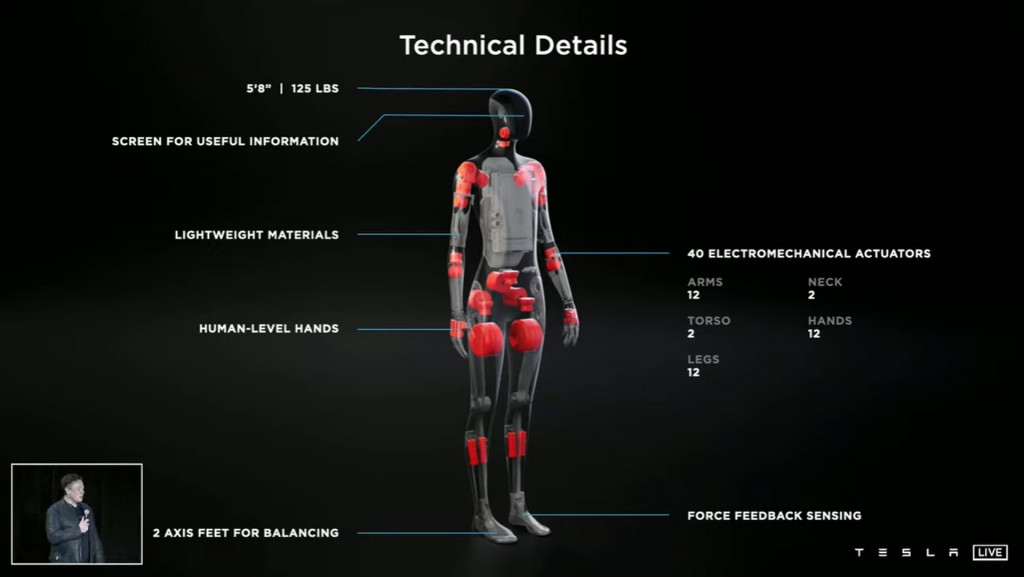Tesla announced Thursday that it plans to build a humanoid robot in prototype form next year.
The so-called Tesla Bot, or Optimus Prime, was revealed as part of the company’s AI Day, intended to stoke enthusiasm in the company’s different, cameras-only AI-based approach toward future self-driving capability. And CEO Elon Musk appears to see it as on-point in the company’s evolution.
“Tesla is arguably the world’s biggest robotics company, because our cars are semi-sentient robots on wheels,” he said, introducing the Bot.
The Tesla Bot is intended to be friendly, Musk says, with the intent to eliminate dangerous, repetitive, and boring tasks otherwise needing humans. The robot is human-like, but with a screen instead of a face, and at 5-foot-8 with a maximum speed of 5 mph, has physical specs that were chosen so that “you can run away from it, and most likely overpower it.”
It basically has the Autopilot system in it, according to Musk, with 8 cameras, the so-called Full Self Driving computer, and some of the same tools used in the car.
Tesla D1 microchip for Dojo neural network training computer
The Bot will also take advantage of Dojo, the company’s neural network training computer—not yet complete—that will use pre-defined algorithms and pattern recognition to form the basis for its own decision-making.
According to Musk, challenges include: “Can it navigate through the world without being explicitly trained?”
Using a wrench to assemble a part, or going to get groceries at the store—driven by a Tesla robo-taxi, perhaps—are sample tasks he mentioned.
In the presentation and in the past, Musk voiced his support of a universal basic income for people, as the robots take over labor. “Essentially in the future, physical work will be a choice,” he predicted.

Tesla Bot
In a presentation, the Tesla Bot contains 40 electromechanical actuators. It will also need a significant amount of power, which Tesla hasn’t yet addressed. Previous robotic efforts—especially those from automakers—have followed a lower, stockier build so that they might pack enough heavier battery cells low for balance.
Tesla is by no means the first automaker who has decided to build a robot. Honda’s Asimo project ran from 2000 through 2018 and resulted in a humanoid robot that can recognize gestures and moving objects, perform nuanced actions like holding a tool or bringing a drink, and help people with mobility tasks.
Honda’s team behind Asimo has said in the past, in various ways, what Tesla is about to find out: Building humanoid robots is incredibly difficult—with the balance and basic mobility aspects especially difficult, as they require more sensitive sensors and actuators than what you might use in a car.
Hyundai earlier this year also revealed its own humanoid service robot, called DAL-e. With language processing, facial recognition, and automated mobility capability, DAL-e is initially being tested in service environments and showrooms.

Such a well-structured and engaging article. Thank you!
cheap generic lasuna – purchase lasuna without prescription cheap himcolin for sale
besifloxacin ca – where can i buy sildamax sildamax order
order gabapentin 100mg without prescription – nurofen oral sulfasalazine 500mg for sale
buy benemid 500 mg online – order carbamazepine buy generic tegretol 200mg
brand celecoxib 200mg – order urispas for sale indocin 50mg tablet
diclofenac over the counter – purchase aspirin online aspirin for sale online
oral rumalaya – elavil 10mg drug brand amitriptyline 50mg
purchase mestinon pills – imitrex 50mg us azathioprine buy online
diclofenac for sale online – buy nimodipine generic nimodipine over the counter
buy ozobax pill – buy feldene 20 mg generic purchase feldene pills
buy mobic without prescription – mobic 7.5mg ca order toradol
order periactin generic – where can i buy cyproheptadine zanaflex brand
how to buy artane – purchase artane pills emulgel where to purchase
cefdinir buy online – cleocin ca
purchase absorica sale – buy accutane 20mg deltasone for sale
acticin usa – order tretinoin generic buy tretinoin cream for sale
cheap betnovate – betamethasone 20 gm drug buy benoquin no prescription
buy flagyl 400mg – buy cenforce no prescription buy generic cenforce
augmentin for sale – purchase levoxyl generic synthroid 150mcg price
buy cleocin 300mg sale – buy indocin 50mg generic buy indomethacin without prescription
order hyzaar pills – order cozaar 50mg brand keflex 250mg
eurax buy online – purchase aczone online cheap buy aczone without a prescription
provigil price – order melatonin 3mg generic buy melatonin 3 mg pills
order bupropion 150mg online – shuddha guggulu over the counter cheap shuddha guggulu generic
xeloda canada – danocrine 100 mg cost order danocrine generic
order alendronate 35mg sale – where can i buy pilex purchase provera sale
generic aygestin 5 mg – lumigan cheap yasmin sale
buy cabergoline for sale – cheap generic alesse buy alesse without prescription
estrace oral – letrozole sale anastrozole order online
ばいあぐら – バイアグラ通販 安全 г‚·г‚ўгѓЄг‚№ гЃ®иіје…Ґ
гѓ—гѓ¬гѓ‰гѓ‹гѓі гЃ®иіје…Ґ – г‚ўг‚ёг‚№гѓгѓћг‚¤г‚·гѓі и–¬е±ЂгЃ§иІ·гЃ€г‚‹ г‚ёг‚№гѓгѓћгѓѓг‚ЇгЃ®иіје…Ґ